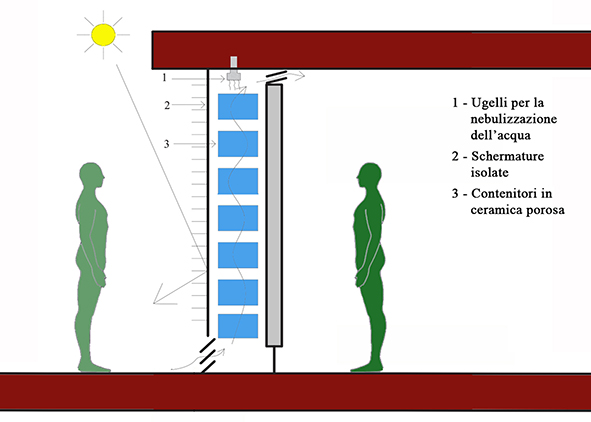Costruire con l’Acqua: nuovi Paradigmi dell’Architettura sostenibile
DOI:
https://doi.org/10.19229/2464-9309/2162017Parole chiave:
acqua, architettura, innovazione, struttura adattiva, componenti multifunzionaliAbstract
All’interno di una prassi architettonica sempre più consolidata che mira alla sostenibilità ambientale e all’autosufficienza energetica, l’articolo riporta ricerche e sperimentazioni condotte in ambito internazionale sul tema acqua-architettura, evidenziando come, partendo dall’ottima capacità del fluido di termoregolare gli ambienti confinati, si possa arrivare a considerare l’acqua anche un materiale componente dell’architettura.
Downloads
##plugins.generic.articleMetricsGraph.articlePageHeading##
Riferimenti bibliografici
Adams, S., Becker, M., Krauss, D. and Gilman, C. M. (2010), “Not a dry subject: optimizing water Trombe wall”, in Proceedings of Solar 2010 Conference, ASES, Colorado.
Bainbridge, D. A. (1981, 2005), A waterwall solar design manual – For environmentally responsive buildings that increase comfort, save money, and protect the environment. [Online] Available at: www.solaripedia.com/files/472.pdf [Accessed 6 September 2017].
Bainbridge, D. A., Haggard, K. and Cooper, P. (2007), “Return of Water Wall”, in Solar Today, July-August 2007, pp. 38-41.
Briga-Sáa, A., Martinsc, A., Boaventura-Cunhad, J., Lanzinhaa, J. C. and Paiva, A. (2014), “Energy performance of Trombe walls – Adaptation of ISO 13790:2008 (E) to the Portuguese reality”, in Energy and Buildings, vol. 74, pp. 111-119. [Online] Available at: doi.org/10.1016/j.enbuild.2014.01.040. [Accessed 11 September 2017].
Cabeza, L. F., Barreneche, C., Miró, L., Morera, J. M., Bartolí, E. and Fernández, A. I. (2013), “Low carbon and low embodied energy materials in buildings – A review”, in Renewable and Sustainable Energy Reviews, vol. 23, pp. 536-542.
Casini, M. (2016), Smart Buildings. Advanced materials and nanotechnology to improve energy-efficiency and environmental performance, Woodhead Publishing-Elsevier.
Corbett, J. and Corbett, M. (2000), Designing Sustainable Communities – Learning from Village Homes, 2nd Edition, Island Press, Washington DC.
Emmitt, S. (2012), Architectural Technology, 2nd Edition, John Wiley and Sons, UK.
Gasperini, K. (2012), Schemi urbani – Tecnologia e innovazione – Nuovi sistemi per le facciate mediatiche, Wolters Kluwer Italia, Milano.
Gupta, A. and Tiwari, G. N. (2002), “Computer model and its validation for prediction of storage effect of water mass in a greenhouse: a transient analysis”, in Energy Conversion and Management, vol. 43, issue 18, pp. 2625-2640.
Gutai, M. (2013), Liquid Engineering Towards New Sustainable Model for Architecture and City, lecture at International Conference on Planning and Environment, Peking University.
Gutai, M. (2015), Trans-Structures: fluid architecture and liquid engineering – Response-able innovative structures, Actar Publishers, New York.
Haggard, K., Cooper, P., Rennick, J. and Niles, P. (2000), “Natural Conditioning of Buildings”, in Elizabeth L. and Adams, C. (eds), Alternative Construction: Contemporary Natural Building Materials, John Wiley and Sons, UK, pp. 37-69.
Hammond, G. P. and Jones, C. I. (2008), “Embodied energy and carbon in construction materials”, in Proceedings of the Institution of Civil Engineers – Energy, vol. 161, issue 2, pp. 87-98.
Hordeski, M. F. (2011), New technologies for energy efficiency, The Fairmont Press, New York.
Liu, X. and Shen, T. (2007), “Conceptual development of transparent water storage envelopes”, in Architectural Science Review, vol. 50, issue 1, pp. 18-25.
Liu, X. and Shen, T. (2008), “The development of transparent water storage envelopes (TWSE) through theoretical thermal and optical analyses”, in Architectural Science Review, vol. 51, issue 2, pp. 109-123.
Mattei, M. G. (ed.) (2012), Carlo Ratti – Smart city, smart citizen, Egea Edizioni, Milano.
Melero, S., Morgado, I., Neila, J. et alii (2011), “Passive evaporative cooling by porous ceramic elements integrated in a Trombe wall”, in Bodart, M. and Evrard, A. (eds), PLEA 2011 – Architecture & Sustainable Development, Presses Univ. de Louvain,
Moustafa, M. A. and Aripin, S. (2014), “CFD evaluation of the pottery water wall in a hot arid climate of Luxor, Egypt”, in Journal of Green Building, vol. 9, issue 4, pp. 175-189.
Rowe, C. (1997), “At the Sink: Architecture in Abjection”, in Lahiji, N. and Friedman, S. D. (eds), Plumbing – sounding modern architecture, Princeton Architectural Press, New York.
Ruban, L. (2014), “Three states of water: how technology makes water a construction material”, in Technical Transactions Architecture, vol. 15, issue 8-A, pp. 27-37.
Saadatian, O., Sopian, K., Lim, C. H., Asim, N. and Sulaiman, M. Y. (2012), “Trombe walls: A review of opportunities and challenges in research and development”, in Renewable and Sustainable Energy Reviews, vol. 16, issue 8, pp. 6340-6351.
Schiaffonati, F. and Mussinelli, E. (2008), Il tema dell’acqua nella progettazione ambientale, Maggioli, Santarcangelo di Romagna (RM).
Schnädelbach, H. (2010), Adaptive Architecture – Conceptual Framework. [Online] Available at: www.researchgate.net [Accessed 12 September 2017].
Simmons, H. L. (2011), Olin’s construction – principles, materials, and methods, John Wiley & Sons, UK.
Thumann, A. and Mehta, D. P. (2008), Handbook of Energy Engineering, Fairmont Press, Florida.
Wang, W., Tian, Z., Niu, X. and Xu, X. (2012), “Investigation on a passive solar house equipped with water thermal storage wall”, in Applied Mechanics and Materials, n. 178, pp. 193-196.
Weston, R. (2004), Plans, Sections and Elevations – Key Buildings of the Twentieth Century, Laurence King Publishing, London.
Williamson, D. A. (2013), “Water and the Architect – Architecture as Decentralized Water Management”, in Theses from the Architecture Program, Paper 164. [Online] Available at: www.digitalcommons.unl.edu/archthesis/164 [Accessed 6 July 2017].
Yang, Q., Zhu, L. H., He, J. J. et alii (2011), “Integrating passive cooling and solar techniques into the existing building in South China”, in Advanced Materials Research, vol. 37, pp. 368-373.
Zhongting, H., Bingqing, L. and Wei, H. (2015), “An experimental investigation of a novel Trombe wall with Venetian blind structure”, in Energy Procedia, vol. 70, pp. 691-698.
Zhongting, H., Wei, H., Jie, J. and Shengyao, Z. (2017), “A Review on the application of Trombe wall system in buildings”, in Renewable and Sustainable Energy Reviews, vol. 70, pp. 976-987.
www.hydropolis.pl [Accessed 12 September 2017].
www.solar-components.com/tubes.htm [Accessed 9 September 2017].

##submission.downloads##
Pubblicato
Come citare
Fascicolo
Sezione
Licenza
AGATHÓN è pubblicata sotto la licenza Creative Commons Attribution License 4.0 (CC-BY).
License scheme | Legal code
Questa licenza consente a chiunque di:
Condividere: riprodurre, distribuire, comunicare al pubblico, esporre in pubblico, rappresentare, eseguire e recitare questo materiale con qualsiasi mezzo e formato.
Modificare: remixare, trasformare il materiale e basarti su di esso per le tue opere per qualsiasi fine, anche commerciale.
Alle seguenti condizioni
Attribuzione: si deve riconoscere una menzione di paternità adeguata, fornire un link alla licenza e indicare se sono state effettuate delle modifiche; si può fare ciò in qualsiasi maniera ragionevole possibile, ma non con modalità tali da suggerire che il licenziante avalli l'utilizzatore o l'utilizzo del suo materiale.
Divieto di restrizioni aggiuntive: non si possono applicare termini legali o misure tecnologiche che impongano ad altri soggetti dei vincoli giuridici su quanto la licenza consente di fare.
Note
Non si è tenuti a rispettare i termini della licenza per quelle componenti del materiale che siano in pubblico dominio o nei casi in cui il nuovo utilizzo sia consentito da una eccezione o limitazione prevista dalla legge.
Non sono fornite garanzie. La licenza può non conferire tutte le autorizzazioni necessarie per l'utilizzo che ci si prefigge. Ad esempio, diritti di terzi come i diritti all'immagine, alla riservatezza e i diritti morali potrebbero restringere gli usi del materiale.



















































































